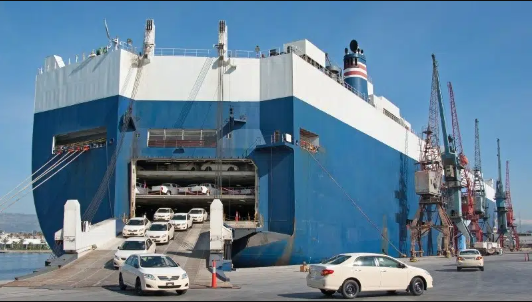Roll-on/Roll-off (RORO or ro-ro) ships are vessels designed to carry wheeled cargo, such as automobiles, trucks, semi-trailer trucks, trailers, and railroad cars, that are driven on and off the ship on their own wheels. This is in contrast to Lift-on/Lift-off (LoLo) vessels, which use a crane to load and unload cargo.
RORO vessels have built-in ramps that allow the cargo to be efficiently rolled on and off the vessel when in port. While smaller ferries that operate across rivers and other short distances often have built-in ramps, the term RORO is generally reserved for larger oceangoing vessels. The ramps and doors may be stern-only, or bow and stern for quick loading.
Types of RORO vessels include ferries, cruiseferries, cargo ships, and barges.
New automobiles that are transported by ship are often moved on a large type of RORO called a pure car carrier (PCC) or pure car/truck carrier (PCTC).
Elsewhere in the shipping industry, cargo is normally measured by the metric tonne, but RORO cargo is typically measured in lanes in metres (LIMs). This is calculated by multiplying the cargo length in metres by the number of decks and by its width in lanes (lane width differs from vessel to vessel, and there are several industry standards).
On PCCs, cargo capacity is often measured in RT or RT43 units (based on a 1966 Toyota) or in car-equivalent units (CEU).
The largest RORO passenger ferry is MS Color Magic, a 75,100 GT cruise ferry that entered service in September 2007 for Color Line. Built in Finland by Aker Finnyards, it is 223.70 m (733 ft 11 in) long and 35 m (114 ft 10 in) wide, and can carry 550 cars, or 1270 lane meters of cargo.
The RORO passenger ferry with the greatest car-carrying capacity is the Ulysses (named after a novel by James Joyce), owned by Irish Ferries.
The Ulysses entered service on 25 March 2001 and operates between Dublin and Holyhead. The 50,938 GT ship is 209.02 m (685 ft 9 in) long and 31.84 m (104 ft 6 in) wide, and can carry 1342 cars/4101 lane meters of cargo.
The first cargo ships specially fitted for the transport of large quantities of cars came into service in the early sixties. These ships still had their own loading gear and so-called hanging decks inside.
Since 1970, the market for exporting and importing cars has increased dramatically and the number and type of ROROs has increased also.
In 1973, Japan’s K Line built the European Highway, the first pure car carrier (PCC), which carried 4,200 automobiles. Today’s pure car carriers and their close cousins, the pure car/truck carrier (PCTC), are distinctive ships with a box-like superstructure running the entire length and breadth of the hull, fully enclosing the cargo. They typically have a stern ramp and a side ramp for dual loading of thousands of vehicles (such as cars, trucks, heavy machineries, tracked units, Mafi trailers, and loose statics), and extensive automatic fire control systems.
The PCTC has liftable decks to increase vertical clearance, as well as heavier decks for “high-and-heavy” cargo.
A 6,500-unit car ship, with 12 decks, can have three decks which can take cargo up to 150 short tons (136 t; 134 long tons) with liftable panels to increase clearance from 1.7 to 6.7 m (5 ft 7 in to 22 ft 0 in) on some decks. Lifting decks to accommodate higher cargo reduces the total capacity.
These kinds of vessels perform a usual speed of 16 knots at eco-speed, while at full speed can achieve more than 19 knots.
With the building of Wallenius Wilhelmsen Logistics’s 8,000-CEU car carrier Faust out of Stockholm in June 2007 car carriers entered a new era of the large car and truck carrier (LCTC). Currently, the largest are Wilh. Wilhelmsen’s “Mark V” ships, led by MV Tønsberg.
The car carrier Auriga Leader, built in 2008 with a capacity of 6,200 cars, is the world’s first partially solar powered ship.
